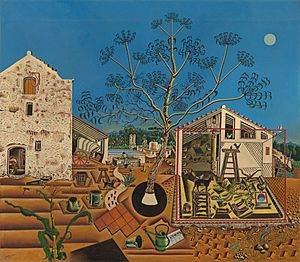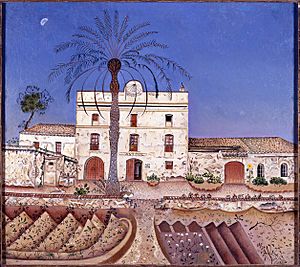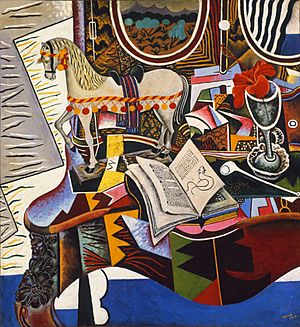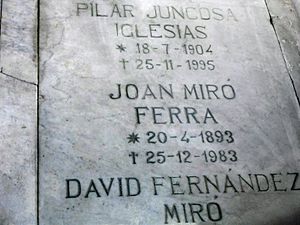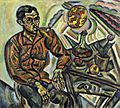Joan Miró facts for kids
Quick facts for kids
Joan Miró
|
|
|---|---|
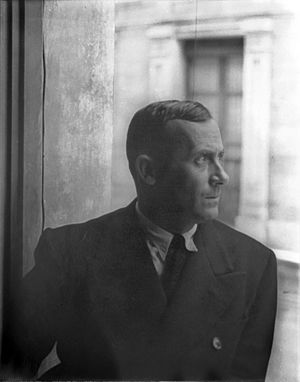
Portrait by Carl Van Vechten, 1935
|
|
| Born |
Joan Miró i Ferrà
20 April 1893 Barcelona, Catalonia, Spain
|
| Died | 25 December 1983 (aged 90) Palma, Mallorca, Spain
|
| Education | Escola de Belles Arts de la Lotja and Escola d'Arte de Francesc Galí, Cercle Artístic de Sant Lluc, 1907–1913 |
| Known for | Painting, sculpture, mural and ceramics |
| Movement | Surrealism |
| Spouse(s) |
Pilar Juncosa Iglésias
(m. 1929) |
| Awards |
|
| Signature | |
 |
|
Joan Miró i Ferrà (born April 20, 1893 – died December 25, 1983) was a famous Spanish artist. He was a talented painter, sculptor, and ceramicist. Miró was born in Barcelona, Spain.
Two museums are dedicated to his amazing artwork. The Fundació Joan Miró is in Barcelona, his hometown. The Fundació Pilar i Joan Miró is in Palma de Mallorca, where he later lived.
Miró started painting when he was fourteen years old. He went to art school to learn and grow. He began to create his own special way of drawing trees and landscapes. Around the 1930s, his art style changed a lot. He was inspired by artists like Pablo Picasso. Miró started making more surrealist artworks. Surrealism is an art style that uses dream-like images.
Miró's art had a big impact on artists in the late 1900s. Especially American abstract expressionist artists were influenced by him. Today, his paintings are very valuable. They can sell for millions of dollars at auctions.
Contents
About Joan Miró's Life
Joan Miró was born into a family of skilled craftspeople. His father was a goldsmith, and his mother's family made watches. Miró grew up in the old Barri Gòtic area of Barcelona.
He started drawing lessons when he was just seven years old. His father wanted him to go into business. But Miró loved art more. In 1907, he joined the fine art academy at La Llotja. He also studied at the Cercle Artístic de Sant Lluc.
Miró had his first art show in 1918. It was at the Galeries Dalmau in Barcelona. Sadly, some people made fun of his work. They even damaged it.
Moving to Paris
Miró saw art shows in Barcelona that featured Fauve and Cubist styles. These art movements used bright colors and geometric shapes. He was drawn to the art scene in Montparnasse, Paris. In 1920, he moved to Paris. However, he always spent his summers in Catalonia, Spain.
Miró first went to business school and art school. He worked as a clerk when he was a teenager. But he had a nervous breakdown and decided to focus only on art.
His early art was influenced by artists like Vincent van Gogh and Paul Cézanne. This period of his work is sometimes called his Catalan Fauvist period. It showed his unique Spanish style.
Developing His Unique Style
After his first show in Barcelona, Miró settled in Paris. He finished many paintings he had started at his parents' summer home in Mont-roig del Camp. One famous painting from this time is The Farm. This artwork showed his move to a more personal style. It also had a strong Spanish feeling.
Ernest Hemingway, a famous writer, bought The Farm. He said it captured the feeling of Spain. Miró went back to Mont-roig every year. He developed symbols and national pride in his art. These ideas stayed with him throughout his career.
Two of Miró's first Surrealist works were Catalan Landscape (The Hunter) and The Tilled Field. These paintings used a symbolic language. This language became very important in his art for the next ten years.
Joining the Surrealists
In 1924, Miró joined the Surrealist group. His art already had symbolic and poetic qualities. It also showed different ideas at the same time. These traits fit well with the Surrealist idea of automatism. This is a way of creating art that comes from dreams and the subconscious mind.
Many of Miró's works from this time became less cluttered. He experimented with collage and new ways of painting. He wanted to break away from traditional art rules. He even called his work "x" in a letter to a friend. The paintings from this period are known as Miró's dream paintings.
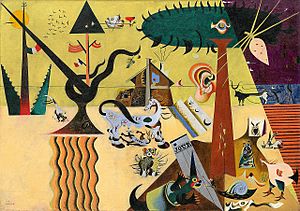
Miró still used subjects in his art. Even with Surrealist techniques, his work often came from careful planning. His art rarely became completely abstract. It kept a symbolic, structured language. This was clear in his Head of a Catalan Peasant series from 1924 to 1925. In 1926, he worked with artist Max Ernst on designs for a ballet.
In 1928, Miró returned to a more realistic style. He created The Dutch Interiors. These paintings were inspired by postcard pictures of works by Dutch artists. They were more like Tilled Field than his earlier dream paintings.
Family Life and New Opportunities
Miró married Pilar Juncosa in Palma on October 12, 1929. Their daughter, María Dolores Miró, was born in 1930.
In 1931, Pierre Matisse opened an art gallery in New York City. This gallery became very important for Modern art in America. Matisse showed Joan Miró's work often. This helped introduce Miró's art to the United States.
In 1932, Miró designed the sets for a ballet called Jeux d'enfants.
Art During War
Before the Spanish Civil War, Miró would go back to Spain every summer. When the war started, he could not return home. Unlike other Surrealist artists, Miró usually avoided politics in his art. But a sense of Catalan pride was in his early works.
His art became more political during the Spanish Civil War. The Spanish Republican government asked him to paint a mural. It was called The Reaper. It was for the Spanish Republican Pavilion at the 1937 Paris Exhibition.
In 1939, with Germany threatening France, Miró moved to Varengeville in Normandy. On May 20, 1940, as Germans entered Paris, he quickly fled to Spain. He stayed there during the war.
Between 1940 and 1941, Miró created a series of twenty-three gouache paintings. They were called Constellations. These works focused on celestial symbols. They showed a new focus on women, birds, and the moon. These themes would be important in his art for the rest of his life.
Later Career and Public Art
In 1948–49, Miró lived in Barcelona. He often visited Paris to work on printing. He became close friends with Fernand Mourlot. Together, they created over a thousand different prints.
In 1959, André Breton asked Miró to represent Spain in an art show. It was called The Homage to Surrealism. Miró created sculptures and ceramics for the Maeght Foundation garden in France. This project was finished in 1964.
In 1974, Miró made a tapestry for the World Trade Center in New York City. He worked with Catalan artist Josep Royo. Miró first said no to making a tapestry. But then he learned the craft from Royo. They made several works together. His World Trade Center Tapestry was lost during the September 11 attacks.
In 1977, Miró and Royo finished another tapestry. It was shown at the National Gallery of Art in Washington, DC.
In 1981, Miró's sculpture The Sun, the Moon and One Star was shown. It was later renamed Miró's Chicago. This large sculpture is in downtown Chicago. It is near another big public sculpture, the Chicago Picasso. Miró had made a small bronze model of it in 1967. This model is now in the Milwaukee Art Museum.
Later Life and Passing
In 1979, Miró received an honorary doctorate from the University of Barcelona. This is a special award given to important people.
Joan Miró passed away at his home in Palma on December 25, 1983. He was 90 years old. He was buried in the Montjuïc Cemetery in Barcelona.
Miró's Unique Art Style
In Paris, Miró was influenced by poets and writers. He developed his own special style. He used organic shapes and flat surfaces. He drew them with clear, sharp lines.
Miró is often seen as a Surrealist artist. His style was influenced by Surrealism and Dada. Dada was another art movement that challenged traditional art. However, Miró did not want to belong to any specific art group.
Miró's Surrealist art came from a place of "repression." This was common for Spanish Surrealist artists. Especially because he was Catalan. His culture faced challenges from the Franco government. Miró also knew about Haitian Voodoo art and Cuban Santería religion. He learned about them during his travels. These influences helped create his unique art style.
Miró's Impact on Art
Miró had a big influence on art in the late 20th century. He especially inspired American abstract expressionist artists. These include artists like Motherwell, Calder, Gorky, Pollock, Matta, and Rothko.
In 1954, he won a prize at the Venice Biennale for his printmaking. In 1958, he received the Guggenheim International Award. In 1981, the Palma City Council created the Pilar and Joan Miró Foundation in Mallorca. It is in the four art studios that Miró gave for this purpose.
Images for kids
-
Joan Miró, 1918, Portrait of Heriberto Casany (Le chauffeur), Kimbell Art Museum.
-
Joan Miró, 1920, Les cartes espagnoles (The Spanish Playing Cards), Minneapolis Institute of Art.
-
Dona i Ocell, 1982, Barcelona, Spain
-
The Fundació Joan Miró Museum on Montjuïc in Barcelona.
-
Pilar and Joan Miró Foundation in Palma de Mallorca. This is Miró's former workshop.
See also
 In Spanish: Joan Miró para niños
In Spanish: Joan Miró para niños


